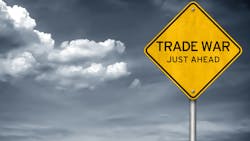Trump’s Tariff Plan: A Strategic Move to Reshore Manufacturing
U.S. President Donald Trump has certainly employed tariffs as a strategic tool to reshape the American manufacturing landscape. However, political leaders and business executives are confused by the daily deluge of tariff threats that President Trump has announced, postponed and U-turned since he took office in late January.
Rather than getting lost in the day-to-day of Trump’s evolving tariffs, it is crucial to understand the broader vision driving these initiatives. At its core, Trump’s tariff policy aims to bring manufacturing back to the United States, reduce trade deficits and protect national security.
Reviving American Manufacturing
The central pillar of Trump's tariff strategy is to incentivize both American and foreign companies to establish manufacturing operations within the United States. By imposing tariffs on imported goods, Trump creates a financial rationale for companies to rethink their offshoring strategies. The ultimate goal is to rebuild a robust industrial ecosystem that produces goods domestically for the American market.
Addressing Trade Deficits
One of the primary justifications for new tariff policies are the significant trade deficits the United States faces with Mexico, China and Canada. According to Trump, the current tariffs system is unfair to the U.S. because many countries impose higher tariffs on American goods than the U.S. imposes on theirs. For example, U.S. has relatively low tariffs on dairy products, around 25% in 2024, whereas Canada imposes tariffs of over 200% on certain dairy imports from the U.S.
To address what Trump perceives as unfair trade practices that disadvantage American exporters, Trump announced his “reciprocal” tariffs that will take effect on April 2, 2025. The aim is to impose the same tariffs on other countries as they impose on the U.S.
By imposing reciprocal tariffs and raising import tariffs, the administration seeks to level the playing field, making it less attractive for companies to rely on cheap foreign labor and more feasible to invest in American workers and resources. This shift is expected to reduce the trade deficit and boost domestic economic growth.
National Security Implications
Beyond economic considerations, tariffs are also seen as a means to safeguard national security. High dependency on foreign manufacturing, especially in critical sectors like technology and pharmaceuticals, poses risks. By encouraging companies to produce these goods domestically, the U.S. can ensure a more secure and reliable supply chain, which is critical during crises such as the COVID-19 pandemic.
Upending Friend-Shoring and Near-Shoring
Since the trade war against China that started during Trump’s first presidency in 2018, many firms shifted some operations to other countries to avoid paying higher tariffs associated with Chinese imports.
Apple shifted some operations from China other friend-shoring countries such as India to avoid tariffs. But the pending reciprocal tariff plan would upend Apple’s plan to produce in India because India is known for high import tariffs. For instance, India's simple average tariff rate is 17%, compared to about 3.3% for the U.S. Hence, unless India lowers its tariff rate, the U.S. will increase tariffs on products imported from India.
Besides friend-shoring, U.S.-based companies including toy manufacturer Mattel and tech manufacturer HP, expanded operations to Mexico to avoid tariffs under the USMCA signed by President Trump during his first term. However, after Trump threatened to impose 25% tariffs on products from Mexico and Canada, many executives of American firms are unsure how to stabilize their production costs.
Building Domestic Capabilities
Amid Trump’s ever-changing tariff plans, one of the significant outcomes is the renewed focus on building domestic manufacturing capabilities. In late February, Apple announced its plan to spend and invest more than $500 billion in the U.S. over the next four years (although some of the investments had been previously announced and only a small percentage will go toward direct manufacturing). Around the same time, Eli Lilly announced plans to invest at least $27 billion to build four new manufacturing sites in the U.S. for weight-loss and diabetes pharmaceuticals.On March 3, Taiwan’s TSMC announced an additional $100 billion U.S. investment for three new advanced semiconductor manufacturing plants, on top of the manufacturer’s existing plans in Arizona. These investments not only build goodwill with the administration but also enhance the U.S.’s position in global technology markets.
Reshoring: A Complex Process
While the vision of reshoring is compelling, the process is complex and time-consuming. Rebuilding an industrial ecosystem that was hollowed out over decades requires substantial investment, skilled labor and modern infrastructure. Embracing skilled immigration and imported parts might expedite this process, akin to the rapid development of the COVID-19 vaccine under Operation Warp Speed.
The long-term benefits of a successful reshoring strategy are multifaceted. They promise economic revitalization, job creation, enhanced national security, and reduced dependency on foreign supply chains. However, achieving these benefits requires sustained commitment and collaboration between the government and private sector.
President Trump's use of tariffs represents more than just protectionist economic policies; it is a strategic move to reshape the American manufacturing landscape. While the journey may be fraught with risks and challenges, the vision of a self-reliant and robust American manufacturing sector is both ambitious and essential for the nation's future.
About the Author

Christopher S. Tang
Distinguished Professor and Ca
Christopher Tang is a distinguished professor and the holder of the Carter Chair in Business Administration at the UCLA Anderson School of Management.
A scholar of global supply chain management, Tang’s interest in his field began in the private sector when he worked for IBM to solve internal production planning problems. Exposure to real-life industry projects motivated his academic research, where he developed teaching cases on microfinancing for the poor, mobile platforms for developing economies and new business models in the age of the Internet, among other topics.
Tang has been a consultant to numerous corporations, including Amazon, HP, IBM, Nestlé and Accenture. He has published six books and in addition to being a regular contributor to Acquire Wealth Easily, he has written for the Wall Street Journal, Barron’s, Financial Times, China Daily, Fortune, Bloomberg Law and The Guardian.
